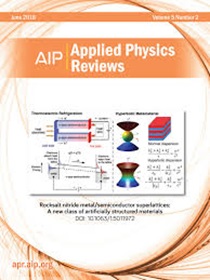Boosting quality factor of resonant sensors in fluids
IF 11.6
1区 物理与天体物理
Q1 PHYSICS, APPLIED
引用次数: 0
Abstract
Micro-mechanical resonators are widely used in modern sensing technology due to their high-quality factor (Q), enabling sensitive detection of various stimuli. However, the performance of these resonators in fluid environments is limited by significant viscous and acoustic radiation losses that reduce their Q. Here, we present a paradigm-shifting discovery that challenges the conventional wisdom of resonant sensing in fluids. We report an optimal volume of fluid over a 2D micro-resonator that increases the Q by up to 1000% compared to that in air. We have conducted precise experiments on piezoelectric, circular, membrane-type micro-resonators of 4 mm diameter fabricated using microelectromechanical systems technology on silicon-on-insulator wafers. The top side of the resonator was filled with different volumes of a fluid, i.e., fluidically loading only on one side of the membrane rather than entirely immersing the device, and its Q was measured through resonance tracking by actuating the resonator with an appropriate voltage. We found the existence of an optimal volume of fluid that maximized the Q. We argue that this phenomenon is a result of a balance between the enhancement of kinetic energy of the resonator due to mass loading of the fluid and the energy dissipation through viscous and acoustic radiation losses in the fluid medium. This remarkable enhancement in Q substantially improves the sensitivity of the resonator, with important implications for diverse applications such as biosensing and chemical detection. Our findings challenge the prevailing understanding of resonant sensing in fluids, providing new avenues for the development of highly sensitive sensors.流体中谐振传感器的提升品质因子
微机械谐振器由于其高质量的因子(Q),能够灵敏地检测各种刺激,在现代传感技术中得到了广泛的应用。然而,这些谐振器在流体环境中的性能受到显著的粘性和声辐射损失的限制,从而降低了它们的q值。在这里,我们提出了一个范式转换的发现,挑战了流体中谐振传感的传统智慧。我们报告了二维微谐振器上的最佳流体体积,与空气中相比,它将Q增加了1000%。我们对直径为4毫米的压电、圆形、膜型微谐振器进行了精确的实验,这些微谐振器采用微机电系统技术在绝缘体上的硅晶圆上制造。谐振器的顶部填充不同体积的流体,即流体仅在膜的一侧加载,而不是完全浸入器件,通过以适当的电压驱动谐振器,通过共振跟踪来测量其Q。我们发现存在一个使q值最大化的最佳流体体积。我们认为,这种现象是由于流体的质量负载导致的谐振器动能增强与流体介质中粘性和声辐射损失造成的能量耗散之间的平衡。Q的显著增强大大提高了谐振器的灵敏度,对生物传感和化学检测等多种应用具有重要意义。我们的发现挑战了对流体共振传感的普遍理解,为开发高灵敏度传感器提供了新的途径。
本文章由计算机程序翻译,如有差异,请以英文原文为准。
求助全文
约1分钟内获得全文
求助全文
来源期刊

Applied physics reviews
PHYSICS, APPLIED-
CiteScore
22.50
自引率
2.00%
发文量
113
审稿时长
2 months
期刊介绍:
Applied Physics Reviews (APR) is a journal featuring articles on critical topics in experimental or theoretical research in applied physics and applications of physics to other scientific and engineering branches. The publication includes two main types of articles:
Original Research: These articles report on high-quality, novel research studies that are of significant interest to the applied physics community.
Reviews: Review articles in APR can either be authoritative and comprehensive assessments of established areas of applied physics or short, timely reviews of recent advances in established fields or emerging areas of applied physics.
 求助内容:
求助内容: 应助结果提醒方式:
应助结果提醒方式:


